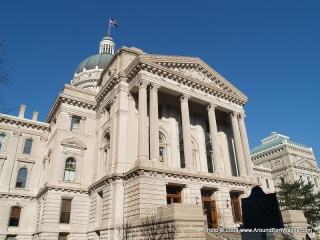E-mail from Aaron Smith, Watchdog Indiana:
Hello Watchdogs,
REASON #3 to support the constitutional property tax caps in Senate Joint Resolution 1 and House Joint Resolution 1 is that farmers will be helped.
The 2008 property tax reform program included House Bill 1001 and the constitutional amendment in the identical Senate Joint Resolution 1 and House Joint Resolution 1. The SJR 1 and HJR 1 constitutional amendment would make the 1% – 2% – 3% property tax caps permanent AND protect property tax deductions and credits from constitutional challenge. Full SJR 1 and HJR 1 information can be found on-line.
Farmers have been ill-served by the Indiana Farm Bureau opposition to SJR 1 and HJR 1 because the 2008 property tax reform program helps farmers in the seven ways listed next.
- Like other homesteads, farm homes and the acre of land they sit on have their property tax cap lowered to 1% of their fair market value from 2%.
- Because farm land uses less of the municipal services normally paid for by property taxes, the cap for farm land is lowered to 2% from 3%.
- The remainder of farm business property taxes are capped at 3%, thereby creating a predictable maximum property tax burden. Average farm business property taxes will continue to be well below the 3% cap for the foreseeable future because the 2008 property tax reform program does not allow any property tax revenue shortfalls resulting from property tax caps to be shifted to taxpayer classes that have not reached their cap level.
- The 2005 agreement with the farm community continues where an assessment mechanism for farm land is implemented that, instead of using the fair market value required of all other real property owners, uses a market value in use approach based on changes in cash rent, yields, production costs, market prices, and interest rates. Starting with the Pay 2008 property tax year, farm land assessment calculations are based on a rolling six-year average calculated by dividing the net income of each acre by the appropriate capitalization rate. For example, the change in the farm land assessed value for the Pay 2010 property tax year was the result of the removal of the 2000 data and the addition of the 2006 data. The Pay 2007 farm land assessed value was arbitrarily frozen by the General Assembly at $880 per acre, while the subsequent calculated assessed values are $1,140 for Pay 2008, $1,200 for Pay 2009, and $1,250 for Pay 2010. An acre of farm land typically appraises at a fair market value of $4,200, and an acre of farm land in Hamilton County sells for up to $40,000.
- Like other Indiana businesses, Indiana farmers will continue to benefit from an accelerated depreciation schedule where farm equipment is fully depreciated within five years to 30 percent of its cost.
- Farmers will continue to benefit from sales tax exemptions on the sale of goods directly used in farming and on utility sales to a person for use in agriculture.
- The following costs are removed from local property taxes and transferred to the state: school general fund costs, child welfare levies, costs of juvenile incarceration in state facilities, state fair and forestry levies, hospital care for the indigent, pre-school special education levies, costs of certain police and fire pensions.
The importance of the 2008 property tax reform program to farmers is emphasized by comparing the increase in the value of farm land to the increase in the net property tax on agricultural business real property (which includes farm land).
Farm land assessed value increased 36.4 percent from $880 per acre in 2007 to $1,200 in 2009. However, according to the December 1, 2009, Property Tax Impact Report from the Legislative Services Agency, the 2009 net property tax of $344.4 million on agricultural business real property was only 10.5 percent more than the 2007 net property tax of $311.7 million. The net property tax on agricultural business real property did not increase at the rate of the farm land assessed value increase because of the costs removed from the 2009 property tax bill by the 2008 property tax reform program.
In particular, the permanent property tax caps in SJR 1 and HJR 1 are important to the Hoosier farmer. Under the market value in use assessment mechanism with a 2% cap, farmers’ property taxes will average 40 percent lower than if their farm lands were assessed at the fair market value and capped at 1%.
The key to any additional property tax relief for farmers depends on the possibility of credits or deductions on the assessed value of farm land. SJR 1 and HJR 1 make such credits and deductions immune to constitutional challenge. Farmers need to tell their Indiana Farm Bureau leaders to change their position of senseless obstruction and support SJR 1 and HJR 1.
The American taxpayer has been generous to farmers with various subsidies. Hoosier farmers should not begrudge the protection given to other Hoosier working families by the constitutional amendment in SJR 1 and HJR 1. Farmers are helped by the 2008 property tax reform program and should accordingly support SJR 1 and HJR 1.
Please contact your State Senator and State Representative to let them know you support the constitutional amendment in the identical Senate Joint Resolution 1 and House Joint Resolution 1. Information on how to identify and contact your General Assembly public servants can be found on-line.
This is Watchdog Indiana E-mail Update #135-122909, and it was sent to 26,091 Hoosiers in 74 counties.
If you received this E-mail indirectly from someone else, you can get E-mail Updates sent directly to you from Watchdog Indiana by putting SUBSCRIBE in the subject line of an E-mail to taxless3@comcast.net.
